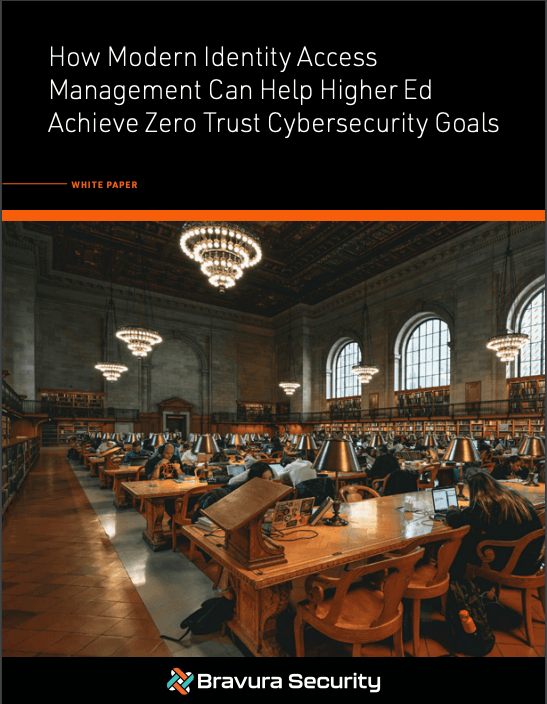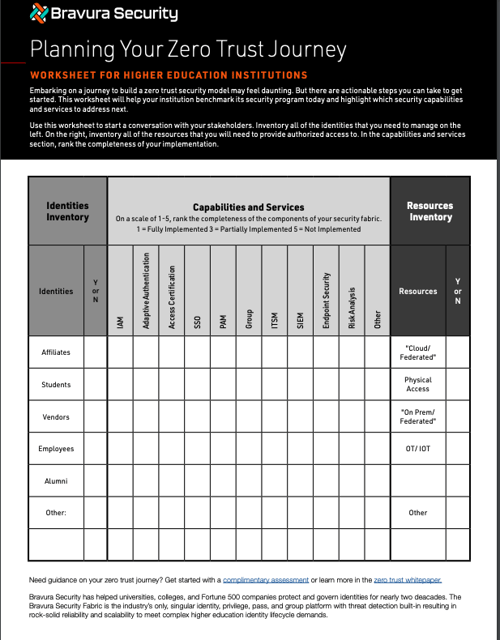How Modern Identity Access Management Can Help Higher Education Achieve Zero Trust Cybersecurity Goals
Higher Education Whitepaper
How to Overcome Common Barriers
Continue to Innovate and Achieve Identity Success
In higher education, the volume of overlapping, fluid identities and data that colleges and universities have to manage and protect makes identity and access management (IAM) a constant burden. It also makes automation a clear priority for higher education IAM. So why aren’t institutions of higher learning lining up to automate these critical processes?
In many cases, concerns surrounding governance policies and the assumption that schools must completely clean up their data before implementing automation stand in the way.
Yet automated processes are the best tool to expedite the data processing needed to maintain the governance state schools are looking to achieve.
This is just one of the automation misconceptions discovered in the survey of more than 100 higher education leaders by Pulse and Bravura Security. Automation is even more essential as more and more organizations set their sites on Zero Trust. Understanding and overcoming common barriers and challenges is critical to meeting Zero Trust standards as higher education continues to innovate its processes to achieve IAM success.

Hurdles Hold Back Critical Growth
Automation and Zero Trust standards may have set the goal posts for IAM success, but success can look very different depending on your organization’s goals. Achieving zero trust cybersecurity while maintaining a secure system is also anything but straightforward for colleges and universities. From the heightened challenges of remote learning to the growing threat of hackers, higher education IT departments have no shortage of challenges to overcome on their way to IAM success.
Budget Constraints
Pre-pandemic, higher education was already facing budget cuts. Covid-19 has only further intensified financial constraints with external budget cuts and enrollment challenges. IT
departments at colleges and universities, in particular, faced unforeseen challenges as they were forced to quickly adapt for remote learning and then strengthen these swift
solutions as the pandemic has continued. This increase in internal IT demand had its own financial outlays and occurred simultaneously to schools needing to tighten their budgets
even further.
In our survey, all IT leaders agreed that budget is a primary roadblock for identity and access management automation. While there’s no easy solution for these financial hurdles,
clearly communicating the full value of IAM automation (reduced information security risk, long-term cost savings, more efficient processes, improved customer service, fewer
errors, etc.) will strengthen efforts to implement these essential processes and solutions.
Existing Infrastructure Investments
Legacy systems make those budget constraints even more challenging to overcome, as many schools have put significant amounts of time and financial investment into these systems and processes. Making the switch to a new automated system is about more than the financial cost, it’s also the time needed to onboard and implement that
new technology — specifically training teams and getting them up to speed with the new IAM solution.
All IT leaders we surveyed selected this as an impediment on the road to automation. Understanding that the investment — both time and cost — is worth the increase in efficiency, security, and so much more will allow colleges and universities to expedite their automation journey.

WHAT IS ZERO TRUST? It's a security concept centered on the belief that organizations should not automatically trust anything inside or outside its perimeters and instead must verify anything and everything trying to connect to its systems before granting access.
nput and outp
Executive Buy-in
Ultimately, automating identity and access management in higher education requires that IT leaders achieve buy-in from all decision makers. While those in the trenches of the IT department may have a clear understanding of the benefits of automation, communicating that with the C-suite can present its own challenges.
While three-quarters of respondents identified executive buy-in as an automation hindrance, for schools struggling to convince decision makers of the value, it can be the sole roadblock to automation. As is the case with budget constraints, presenting the ROI of automation (time saved, decrease in human error, and as a result, reduced long-
term costs) will be key in convincing leadership to commit to this essential evolution.
All of these challenges certainly present stumbling blocks on the path to IAM automation and Zero Trust for colleges and universities, but it’s not an impossible goal. Clear communication of the benefits will be critical as higher education IAM moves forward.
Leaders Value Key IAM Automation Payoffs
Identity and access management automation is an undeniable game changer in higher education, with countless advantages for colleges and universities. So, when Bravura Security worked with Pulse to survey IT leaders in higher education, we were a little surprised by the narrow scope of some of the results. When asked what automation benefits they’re most looking forward to, most of the answers centered around three categories:
- Reduced security risk
- Boosted confidence in compliance status
- A shift from reactive to proactive threat detection
All of these are certainly key benefits for higher education; however, the payoffs for colleges and universities go well beyond this shortlist. Automation can increase efficiency, resiliency, and accuracy in a number of ways and smooth the road toward Zero Trust processes and solutions.
PRO TIP: Having one, integrated solution can ensure schools truly see the ROI of IAM automation. When reviewing IAM solutions, don’t forget to consider connectors for both input and output. Seamless connections between your IT platforms is a key success factor.
More Time for Strategic Initiatives
While just over a third of respondents showed interest in this benefit, the importance of time saved cannot be overstated. Institutions no longer have to spend time manually managing IAM and can instead dedicate those resources to more innovative projects. Whether it’s developing an app, streamlining processes across departments, or focusing on end
user experience, the removal of the more time-consuming parts of identity and access management allows colleges and universities to devote more resources towards strategic initiatives.
Improved End User Experience
With so many other priorities to manage, user experience can get left behind. Our recent survey certainly reflected this with only 13% of respondents noting it as an expected benefit. A mostly remote student body has made this an even more essential consideration. Our survey reflected that 98% of those surveyed said UX improvement has risen in importance
following the mass work-from-home migration and the broad swath of resources being accessed remotely.
Remote access has also added another dimension to UX with IT teams needing to account for how remote students and faculty can reach support (for password problems or more serious issues) when the need arises. Schools that overlook this vital piece of the IAM roadmap may expedite processes in the short-term, but poor UX can create extra work (i.e.,
onboarding challenges and overall usage issues) down the road if neglected for too long.
Simplified Workflows and Streamlined, Modernized Processes
Never underestimate the power of simpler processes. These automation bonuses may have only sparked excitement in around 10% of IT leaders surveyed, but streamlined workflows can make all the difference for universities. This is especially true for larger institutions who are tasked with identity and access management across multiple departments and colleges where automation can save countless hours.
Having a truly integrated solution can help schools take full advantage of their automated IAM with a system that both keeps sensitive information secure and easy to access for those with the right privileges, without jumping through hoops or unsecured integrations.
Automation + Zero Trust = Higher Education IAM Success
As schools continue on the road to Zero Trust, IAM automation will be a critical tool to maintain the tight access the architecture (and higher education) requires. By automating tasks that are critical to a Zero Trust environment to effectively enforce least privilege access, schools not only save on time and costs, they also sidestep human error and
maintain essential governance standards.
As the Pulse and Bravura Security survey found, higher education leaders understand the value of IAM automation. Now is the time to take those important first steps towards implementing a solution that can help them make it a reality.
Next Steps
Learn More About IA Automation Challenges and Benefits
To see the full results of the survey and learn more about IAM automation challenges and benefits for higher education in our resource, download our one-minute white paper.
Want to learn more about Zero Trust? Read our comprehensive: Zero Trust Security Guide
Get an Access Management Assessment
A Roadmap Built for Your Institution
Our partner will work with your team of stakeholders to build a complementary roadmap with small, high-impact projects that will get you the best ROI. Plan how to modernize your identity governance and administration to get started achieving your digitization and cybersecurity goals.
REQUEST A COMPLIMENTARY ASSESSMENT
Futureproof Your Institution Against Cybersecurity Attacks
Read how universities and colleges have modernized their identity access management and governance programs with the Bravura Security Fabric. Access special pricing offers and more.
Learn more
